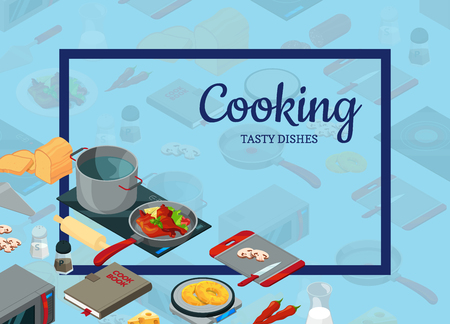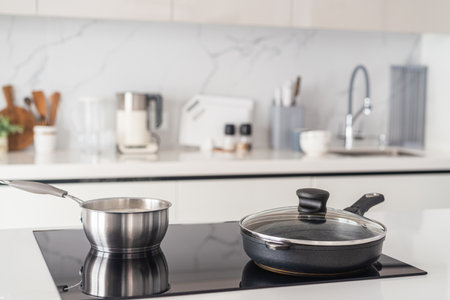Introduction to Indian Kitchen Needs
When it comes to choosing the best kitchen countertop materials for Indian cooking, it is important to understand the unique requirements of an Indian kitchen. Indian cuisine involves high-heat cooking methods like tadka (tempering), deep-frying, and grilling, which can put significant stress on countertop surfaces. The frequent use of a wide variety of spices—many of which can stain or leave marks—and the tradition of preparing multiple meals daily make durability and easy maintenance top priorities. Countertops in Indian homes must withstand everything from rolling rotis and chopping vegetables to handling hot pans straight off the stove. Therefore, selecting the right material that can handle these daily demands while also fitting into Indian aesthetic preferences and cultural practices is essential for a functional and long-lasting kitchen.
Granite Countertops: Traditional and Durable
In most Indian homes, granite countertops remain a top choice for kitchens, and for good reason. Granite is widely appreciated across India not only for its traditional look but also for its ability to withstand the demands of Indian cooking. The intense heat from tawa, hot pans, and pressure cookers is no match for granite’s natural heat resistance. This feature is especially important in Indian households where cooking styles often involve high temperatures and frequent use of heavy cookware.
Another reason why granite is so popular in India is its ease of cleaning. Indian cuisine involves various spices, oils, and masalas, which can leave stains or residues on some surfaces. Granite countertops, however, are relatively non-porous when properly sealed, making it easy to wipe away spills and prevent stubborn stains. A simple swipe with a damp cloth and mild soap is usually enough to keep your kitchen looking fresh and hygienic.
The aesthetic appeal of granite cannot be overlooked either. It comes in a wide range of colours and patterns, allowing homeowners to choose what best matches their kitchen décor. From classic black and earthy browns to vibrant reds and subtle greys, granite offers options that complement both modern modular kitchens and more traditional Indian designs.
Why Granite is Preferred in Indian Kitchens
| Feature | Benefit for Indian Cooking |
|---|---|
| Heat Resistance | Withstands hot vessels without damage |
| Easy Maintenance | Quick cleaning after oily or spicy spills |
| Aesthetic Variety | Matches diverse kitchen styles |
| Durability | Long-lasting even with heavy usage |
If you are looking for a countertop material that balances tradition, durability, and style—granite remains one of the best choices for Indian kitchens.

3. Quartz Countertops: A Modern Option
Quartz countertops have become increasingly popular in Indian homes, especially among families seeking a blend of style and practicality in their kitchen. One of the biggest advantages of quartz is its non-porous surface, which means it does not absorb liquids or food particles. For Indian cooking, where ingredients like turmeric, red chilli powder, and various masalas are commonly used, this quality is a game changer. Traditional spices can easily stain natural stones, but quartz resists these stains effortlessly, making cleaning up after meal prep less stressful.
Another benefit of quartz is its durability and low maintenance. Unlike natural stones that require regular sealing, quartz surfaces stay polished and new-looking with minimal effort. This is particularly helpful for busy Indian households where the kitchen is always bustling with activity—from rolling rotis to preparing tadka. Additionally, quartz countertops are available in a wide range of colours and patterns, allowing homeowners to choose shades that complement their modular kitchen designs or traditional décor preferences. Whether you prefer subtle whites or vibrant tones reminiscent of Indian festivals, there’s a quartz countertop to match your taste.
For families who want both aesthetics and performance in their kitchen space, quartz stands out as a modern and reliable choice for Indian cooking needs.
4. Marble Countertops: Elegance with Care
Marble countertops are a timeless choice for Indian kitchens, offering an unmatched elegance and a cool surface ideal for tasks like rolling chapatis or kneading dough. The natural cooling property of marble is especially valued in Indian cooking, where temperature-sensitive preparations such as mithai (sweets) and rotis require a steady, cool worktop. However, when considering marble for your kitchen, it’s essential to balance its beauty with the level of care it demands.
Advantages of Marble Countertops in Indian Kitchens
| Feature | Benefit |
|---|---|
| Natural Cooling | Keeps doughs and sweets at the right texture during preparation |
| Aesthetic Appeal | Adds a premium, classic look suited to both modern and traditional Indian homes |
| Heat Resistance | Can handle hot pots and pans briefly without damage |
Caring for Marble: Stains & Maintenance in Indian Cooking
Despite its visual charm, marble is porous and prone to staining from common Indian ingredients such as turmeric, mustard oil, and tamarind. These vibrant spices and oils can seep into the stone, leaving behind stubborn marks that are hard to remove.
Essential Maintenance Tips:
- Immediate Cleaning: Wipe spills quickly to prevent permanent stains from masalas or curry splatters.
- Sealing Regularly: Apply a quality sealant every few months to create a protective barrier against moisture and coloured spices.
- Mild Cleaners Only: Avoid harsh chemicals; use gentle soap and water to clean surfaces daily.
- Avoid Acidic Ingredients: Lemon juice or vinegar can etch the marble surface—always use a chopping board for citrus or tomatoes.
Is Marble Right for Your Desi Kitchen?
If you love the regal touch of marble but are ready for some extra cleaning, this material can be a wonderful fit for your home. It’s especially suitable for households where traditional Indian sweets or breads are prepared regularly. However, for heavy-duty cooking with frequent use of colourful spices, families should weigh the maintenance effort against the marble’s stunning appearance. Consider your family’s cooking habits before making the final choice.
5. Stainless Steel Countertops: Hygienic and Functional
Stainless steel countertops have rapidly gained popularity in contemporary Indian kitchens, especially among urban families and professional chefs. Traditionally found in restaurant settings, stainless steel is now making its way into residential homes due to its remarkable blend of hygiene, durability, and effortless maintenance. In the context of Indian cooking—where masalas, oils, and vibrant spices are daily staples—stainless steel offers a non-porous surface that does not absorb stains or odours. This makes it exceptionally easy to clean after preparing dishes like tadkas or rolling out rotis. Moreover, stainless steel resists corrosion and heat damage, which is crucial when placing hot pots or kadais directly on the countertop. Its sleek, modern look complements both minimalist and traditional Indian kitchen designs, providing an aesthetic that appeals to a wide range of tastes. Importantly, stainless steel is also considered a hygienic choice as it inhibits bacterial growth—a top priority for Indian households mindful of health and cleanliness. For busy families who value functionality alongside style, stainless steel countertops deliver both long-lasting performance and peace of mind.
6. Comparing Cost, Maintenance, and Longevity
When choosing the best kitchen countertop material for Indian cooking, it is essential to balance your budget, maintenance capacity, and the longevity you expect from your kitchen workspace. Here’s an overview of how popular countertop materials perform in these areas, catering to typical Indian household needs.
Granite: Premium Looks, Lasting Value
Granite is a favourite in many Indian homes due to its luxurious appearance and exceptional durability. Although granite is on the higher end in terms of cost, its longevity makes it a worthy investment for families looking for a one-time installation that can withstand heavy use. Maintenance is moderate—granite needs periodic sealing but resists stains from masalas and oil splatters common in Indian cooking.
Quartz: Low Maintenance and Modern Appeal
Quartz offers a modern finish and comes in a wide variety of colours. It is non-porous, making it highly resistant to stains from turmeric or curries. Its price range is similar to granite or slightly lower depending on the brand and finish. For busy Indian households seeking easy cleaning with minimal fuss, quartz is ideal—just wipe down after use without worrying about regular sealing.
Marble: Classic Elegance with Careful Upkeep
Marble remains a traditional choice for North Indian kitchens thanks to its cool surface, perfect for rolling rotis or kneading dough. However, marble can be expensive and requires attentive maintenance as it stains easily with acidic ingredients like tamarind or lemon. Regular sealing and quick cleaning are musts, making it better suited to homes willing to invest time in upkeep.
Laminates: Budget-Friendly and Versatile
Laminates are highly cost-effective and available in many designs that mimic more expensive stones. They suit families on a tight budget or those renovating rental homes. However, laminates have lower heat resistance and may not last as long as stone options if exposed to hot cookware or sharp knives—regular care can extend their life, but they are best for light to moderate cooking.
Stainless Steel: Practicality Meets Hygiene
A staple in many South Indian commercial kitchens, stainless steel countertops are affordable, virtually indestructible, and easy to clean. They resist heat and stains perfectly but may develop scratches over time. If hygiene and quick cleanup are top priorities—and you don’t mind an industrial look—stainless steel fits well within most budgets.
Concrete: Customisable and Contemporary
Concrete countertops are gaining popularity among urban Indian homeowners who want a custom look at mid-range prices. They offer good durability but require sealing to avoid absorption of oils and spices. With proper care, concrete surfaces can last decades while fitting both modern aesthetics and practical kitchen needs.
Ultimately, your choice should reflect your family’s cooking habits, design preferences, willingness for maintenance, and budget flexibility. Whether you prioritise resilience against daily tadka or seek a stylish upgrade for entertaining guests, there’s a perfect countertop material for every Indian kitchen scenario.
7. Tips for Choosing the Right Material for Your Indian Kitchen
Selecting the best countertop material for your Indian kitchen is more than just picking a pretty surface; it’s about finding a practical solution that fits your unique lifestyle and cooking needs. Here are some key tips to guide you:
Assess Your Cooking Style
If you love preparing traditional Indian dishes like curries, rotis, or deep-fried snacks, choose a material that can withstand heat, oil spills, and frequent cleaning. Granite and quartz are excellent options as they resist stains and can handle hot pots without damage.
Consider Family Size and Usage
Larger families or joint households usually need robust, low-maintenance surfaces due to higher meal prep frequency. Materials such as granite or solid surface countertops are ideal for heavy use, while smaller families might opt for stylish yet easy-to-maintain quartz or laminate options.
Factor in Regional Preferences
Climate and local traditions can influence your choice. In humid regions like Kerala or West Bengal, non-porous materials such as quartz prevent moisture absorption and mould growth. In drier areas, natural stones like granite remain cool and are preferred for rolling chapatis or kneading dough.
Budget Wisely
Set a realistic budget before you start shopping. While granite and quartz may have higher upfront costs, their durability means lower maintenance expenses over time. Laminate offers an affordable alternative with a wide range of designs but may require more frequent replacements.
Think About Maintenance
If you prefer hassle-free upkeep, choose materials that don’t need sealing or special cleaners. Quartz is virtually maintenance-free, while granite requires periodic sealing to stay stain-resistant.
Match with Kitchen Aesthetics
Your countertop should complement the overall look of your kitchen. For a classic Indian kitchen vibe, black or brown granite pairs beautifully with wooden cabinets. For modern homes in metros like Mumbai or Bangalore, sleek white quartz or colourful laminates add a contemporary touch.
Prioritise Functionality Over Trends
Trendy materials may look appealing but might not suit everyday Indian cooking demands. Always prioritise durability and practicality to ensure your countertop stands up to years of masala splashes, hot kadais, and rolling pins.
By keeping these tips in mind, you’ll find a kitchen countertop that not only looks good but also supports the vibrant flavours and traditions of Indian home cooking.


